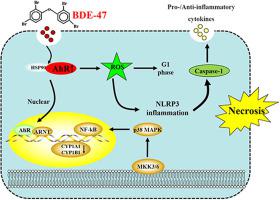Ecotoxicology and Environmental Safety ( IF 6.2 ) Pub Date : 2021-06-17 , DOI: 10.1016/j.ecoenv.2021.112423 Jie Tang 1 , Bo Hu 1 , Huaping Zheng 2 , Xiaolan Qian 1 , Yi Zhang 1 , Jia Zhu 3 , Guangtao Xu 4 , Deqing Chen 4 , Xin Jin 4 , Wanlu Li 4 , Long Xu 5

|
Tetrabromodiphenyl ether (BDE-47) is widely used as commercial flame retardants that can be released into the environment and finally enter human body through the food chain. It has been identified to generate neurotoxicity, but little is known about auditory damage and the underlying mechanism following BDE-47 exposure. This study aimed to assess the cell viability with BDE-47 concentration ranging from 0 to 150 μM in mouse organ of Corti-derived cell lines (HEI-OC1). Aryl hydrocarbon receptor (AhR) as an environmental sensor, reactive oxygen species (ROS), NLRP3 inflammasome and p38 MAPK pathways were detected. Results: (1) BDE-47 inhibited the viability in a time- and dose-dependent way in HEI-OC1 cells. Cell cycle was arrested in G1 phase by BDE-47; (2) Elevated intracellular ROS, LDH levels and necrosis were found, which was alleviated by pretreatment with ROS scavenger N-acetylcysteine (NAC); (3) AhR plays an essential role in ligand-regulated transcription factor activation by exogenous environmental compounds. We found increased expression of AhR and decreased downstream targets of CYP 1A1 and CYP 1B1 in BDE-47-treated HEI-OC1 cells, which was reversed by the AhR antagonist CH-223191 for 2 h before BDE-47 exposure. No significant change was detected in CYP 2B; (4) Enhanced expressions of NLRP3 and caspase-1 were induced by BDE-47, with up-regulations of both pro-inflammatory factors for IL-1β, IL-6 and TNF-α, and anti-inflammatory factors for IL-4, IL-10 and IL-13, but down-regulation for IL-1α; (5) Additionally, the p38 MAPK signaling pathway was activated with increased phosphorylation levels of MKK/3/6, p38 MAPK and NF-kB. Overall, our findings illustrate a role of AhR in ROS-induced necrosis of cochlear hair cells by BDE-47 exposure, in which NLRP3 inflammasome and p38 MAPK signaling pathways are activated. The current study first elucidates the sense of hearing damage induced by BDE-47, and cell-specific or mixture exposures in vivo or human studies are needed to confirm this association.
中文翻译:

2,2',4,4'-四溴二苯醚 (BDE-47) 激活芳烃受体 (AhR) 介导的 ROS 和 NLRP3 炎症小体/p38 MAPK 通路,诱导耳蜗毛细胞坏死
四溴二苯醚(BDE-47)被广泛用作商业阻燃剂,可释放到环境中并最终通过食物链进入人体。它已被确定会产生神经毒性,但对听觉损伤和 BDE-47 暴露后的潜在机制知之甚少。本研究旨在评估小鼠 Corti 衍生细胞系 (HEI-OC1) 器官中 BDE-47 浓度范围为 0 至 150 μM 的细胞活力。检测到作为环境传感器的芳烃受体 (AhR)、活性氧 (ROS)、NLRP3 炎症小体和 p38 MAPK 通路。结果:(1)BDE-47以时间和剂量依赖性方式抑制HEI-OC1细胞的活力。细胞周期被BDE-47阻滞在G1期;(2) 发现细胞内ROS、LDH水平升高和坏死,通过用 ROS 清除剂 N-乙酰半胱氨酸 (NAC) 预处理可以缓解;(3) AhR 在外源环境化合物对配体调节的转录因子激活中起重要作用。我们发现,在 BDE-47 处理的 HEI-OC1 细胞中,AhR 表达增加,CYP 1A1 和 CYP 1B1 下游靶标降低,在 BDE-47 暴露前 2 小时,AhR 拮抗剂 CH-223191 可以逆转这种情况。CYP 2B 未检测到显着变化;(4) BDE-47诱导NLRP3和caspase-1的表达增强,IL-1β、IL-6和TNF-α的促炎因子和IL-4的抗炎因子均上调, IL-10 和 IL-13,但下调 IL-1α;(5) 此外,p38 MAPK 信号通路随着 MKK/3/6、p38 MAPK 和 NF-kB 磷酸化水平的增加而被激活。全面的,我们的研究结果说明了 AhR 在 BDE-47 暴露引起的 ROS 诱导的耳蜗毛细胞坏死中的作用,其中 NLRP3 炎症小体和 p38 MAPK 信号通路被激活。目前的研究首先阐明了 BDE-47 引起的听觉损伤,需要体内或人体研究细胞特异性或混合物暴露来证实这种关联。











































 京公网安备 11010802027423号
京公网安备 11010802027423号